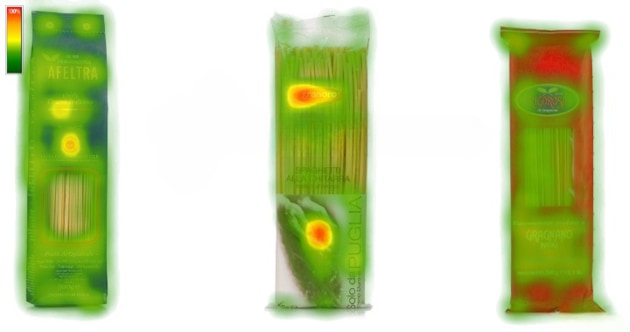Neuromarketing expert Francesco Pinci reveals results of research using Eye Tracker technology to uncover the visual elements in packaging which consumers are most attracted to. This is his second article published in PKN on this fascinating technology.

Two separate studies were undertaken to understand scientifically which packaging elements were found to be most attractive to consumers, using Eye Tracker technology, which works using near-infrared light to create reflection patterns on the cornea and pupil of the eye, and hi-definition cameras to capture images of the eyes and detect patterns in the reflection.
Three packages of pasta from three different brands, all distributed by Eataly, were selected, each with unique characteristics and prices. Surveys were conducted for each study, and data was compared to the survey responses.
The first study took place at the Cosmic laboratory of Roma tre University with 30 voluntary candidates. In the second study, the same survey was distributed online to more than 300 people to validate the first study, to see if the same choice pattern was followed, and to determine the key features of packaging that drove the decision-making process as well as the price perceptions.
Each study also undertook an enquiry on different stimuli that may or may not attract the customer, by asking questions such as:
- How much do characteristics like colour, logo, brand name, and transparency influence choice?
- How much does the price affect the choice of participants?
- How important is the price for the participant on a scale from 1 (a little) to 7 (a lot)?
Results
The results of the first part of the study shows how all the characteristics of the different packaging are perceived. Table 1 generally depicts trends of the factors that have or have not influenced the candidate's choices.
The characteristics taken into consideration are colour, brand name, transparency and packaging material. Each domain is divided in turn into two different values, which correspond to the results entered in the surveys by the candidates.
In the eye tracking study the interaction effect choice x AOI was significant. The pairwise contrasts showed that, when comparing the Afeltra and Granoro brands, the differences in the time spent on the AOIs, depending on the participants’ choice, was significant.
The first section examined the Afeltra pasta packaging. This was related to the area of interest where all three types of pasta are present. It was found that comparatively, the consumer spends more time (%) choosing the Afeltra pasta brand. In the second section, the Granoro pasta was analysed and compared with the other two pasta brands. In this case, the average values of the time (%) spent is quite similar to each other.
In the last section, the Rigorosa pasta brand was analysed. An obvious similarity was found between the median and mean values, and the distributions of the elapsed time (%). In the distribution for the Rigorosa pasta for a few subjects, the % of time spent is around 60%.

The Rigorosa brand was selected during the first phase, without price, by 7 candidates out of 30, and all of them confirmed in the second part of the experiment that the price did not change their choice, but rather confirmed it.
The Granoro brand took second position in the pre-price phase, but first position in the post-price phase, as 12 out of 30 people chose Granoro here.
It was found that the price and the idea of the packaging is well aligned with the customer's expectation. The Afeltra brand was chosen by 14 out of 30 people in the pre-price phase. After discovering the price of Afeltra pasta (the most expensive pasta package), only 6 out of 14 candidates decided not to choose Afeltra, even though the price was the highest, and around double the least expensive brand.
For the online study, we compared the choices in two different periods of time – that is, before knowing the price and after knowing the price. For simplicity, I’ve defined the first stage in which consumers were unaware of the price as pre-price, while in the second phase the price is defined as post-price.
The first choice, where the price was not shown, revealed that:
- Granoro took first place, with 169 people out of 385, (around 43.89%), which included 72 females and 93 males, making the choice.
- Afeltra took second place, with 165 people out of 385 (around 42.85%), which included 91 females and 78 males, making the choice.
- Rigorosa took third place, with 51 people out of 385 (around 13.24%), which included 33 females and 18 males, making the choice.
A table detailing these conclusions was compiled, which extracted only the elements that influenced the candidates for all the selected products (Table 1).
Granoro, in the pre-price phase, was in first place with 169 people (about 43.89%), while in the post-price phase it reached 218 people (about 56%), obtaining more than 12% given by the choice of price. Rigorosa, in the pre-price phase, was in last position with 51 people (13.24%), while in the post-price phase it reached 94 people (about 24%) of the total choice. Afeltra, in the pre-price phase, was in second place with 165 people (42.85%), almost equal to Granoro; while in the post-price phase only 73 people chose it, thus lowering the percentage to 18% and losing about 29% for a price considered too high.
Table 1: (how the elements influence the group for each brand)
|
|
Afeltra 165 |
Granoro 169 |
Rigorosa 51 |
|
Colour |
113 |
92 |
31 |
|
Brand name |
35 |
80 |
29 |
|
Transparency |
67 |
109 |
16 |
|
Logo |
74 |
75 |
21 |
|
Material |
112 |
81 |
26 |
|
Quality |
101 |
110 |
36 |
We can see how the choices of the respondents changed drastically. It is noted that Granoro acquires a great advantage from the selling price, while Afeltra in the post-price phase finds itself in the last position, since the price is considered to be too expensive compared to that of competitors, about double the cheapest.
Comparison
The data from the two research is congruent, both in the pre-price phase and in the post-price phase. The research shows that Granoro and Afeltra brands share second position, and have an almost equal score, while the Rigorosa brand consistently remains detached from the other two brands.
In the first study, the Granoro brand takes first place with three times the score compared to the Rigorosa brand, while in the second study, carried out in the laboratory, the Afeltra brand takes first place with double the score of the Rigorosa brand.
In the post-price phase, as seen previously, the results of both searches confirmed Granoro in first place, Rigorosa in second and finally Afeltra in third place.
Table 2: (Comparison between the pre and post-price of the 2 studies)
|
|
Pre-price online experiment |
Pre-price laboratory experiment |
Post-price online experiment |
Post-price laboratory experiment |
|
Granoro |
169 |
9 |
218 |
12 |
|
Afeltra |
165 |
14 |
94 |
11 |
|
Rigorosa |
51 |
7 |
73 |
7 |
In neuromarketing research, packaging variables are commonly measured as a combination of modifications. We examined whether isolated packaging features can modify consumers' attention levels and preference for a product. Thus, three packaging variables were tested independently: transparency, colour and logo.
In study 1, eye tracking data and survey data are congruent, as more time and fixation were high on Afeltra and then on Granoro. Therefore, we concluded that it is the better choice.
In study 2, the data is consistent with study 1 and supported our objectives. The results indicate that images, either product context or logo, showed strong differences in time of attention, number of fixations and time to first fixation compared with packages without images. According to the analysed data, subjects also reported preference for packages with images.
The present study has several limitations. The various experiments focus only on consumer perceptions and specific pasta packaging – a particular type of product and its packaging projects, in this case, spaghetti packaging, distributed by Eataly.
Consequently, additional elements that make up the package design and their influence on the consumer's purchasing behavior could be investigated and researched.
ABOUT THE AUTHOR
Francesco Pinci is a neuro marketing expert working globally for the last four years. He graduated with a Master’s degree in cognitive science at Roma Tre University (Italy), having a period of study both at Ghent University (Belgium) in 2018, a Belgian institute and at Concordia University (Canada) in 2019. During these training periods, Pinci devoted himself to the study of decision-making and consumer behaviour, considered crucial factors for working in the world of marketing, and published several articles. He has an interest in social psychology and in the use of computers to simulate both cognitive and social processes





